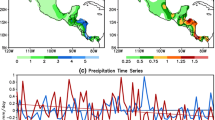Abstract
The variations of surface air temperature (SAT) over the Arctic are closely related to global climate change. Based on reanalysis datasets and a newly defined Aleutian Low intensity index, we found a good correlation between intensity of winter Aleutian Low and the SAT over the Arctic during the subsequent summer. Explanations were given using correlation analysis, composite analysis, and singular value decomposition methods. When intensity of winter Aleutian Low was weaker, sea surface temperature appeared higher in the North Pacific in the subsequent spring and summer, resulting in mean meridional circulation anomalies and 500 hPa geopotential height anomalies in spring and summer. Anomalous upward motion in mid-latitudes and downward motion in high latitudes (Ferrel cell weakening) transported the warmer air to the north from lower layer to the upper layer followed by increases in the SAT over the Arctic. Anomalous downward motion over about 75°N also caused consequent adiabatic warming and contributed to inhibit the heat transportation from surface to upper layer. Negative 500 hPa geopotential height anomalies existed in mid-latitudes and positive anomalies existed in high latitudes. The pattern (low-in-south and high-in-north) benefited from increasing the inflow volume flux of the Bering Strait, which also made the SAT over the Arctic increase. The results of this study reveal the process that the summer SAT over the Arctic was modulated by interannual variability of intensity of winter Aleutian Low.







Similar content being viewed by others
References
Kaufman DS, Schneider DP, McKay NP et al (2009) Recent warming reverses long-term Arctic cooling. Science 325:1236–1239
Serreze MC, Walsh JE, Chapin FS et al (2000) Observational evidence of recent change in the North high-latitude environment. Clim Change 46:159–207
Hinzman LD, Neil DB, Bolton WR et al (2005) Evidence and implications of recent climate change in North Alaska and other Arctic regions. Clim Change 72:251–298
Wang XJ, Jeffrey RK (2003) Recent trends in Arctic Surface, cloud, and radiation properties from space. Science 299:1725–1728
Pearson RG, Phillips SJ, Loranty MM et al (2013) Shifts in Arctic vegetation and associated feedbacks under climate change. Nat Clim Change 3:1–5
Wu BY, Su JZ, Zhang RH (2011) Effects of autumn–winter Arctic sea ice on winter Siberian High. Chin Sci Bull 56:3220–3228
Trenberth KE, Hurrell JW (1994) Decadal atmosphere-ocean variations in the Pacific. Clim Dyn 9:303–319
Trenberth KE (1990) Recent observed interdecadal climate changes in the North Hemisphere. Bull Am Meteorol Soc 71:988–993
Beamish RJ, Neville CE, Cass AJ (1997) Production of Fraser river sockeye salmon (Oncorhynchus nerka) in relation to decadal-scale changes in the climate and the ocean. Can J Fish Aquat Sci 54:543–554
Overland JE, Adams JM, Bond NA (1999) Decadal variability of the Aleutian Low and its relation to high-latitude circulation. J Clim 12:1542–1548
Sun JQ, Wang HJ (2005) Relationship between Arctic oscillation and Pacific decadal oscillation on decadal timescale. Chin Sci Bull 51:75–79
Park YH, Yoon JH, Youn YH et al (2012) Recent warming in the western North Pacific in relation to rapid changes in the atmospheric circulation of the Siberian High and Aleutian Low systems. J Clim 25:3476–3493
Latif M, Barnett TP (1995) Causes of decadal climate variability over the North Pacific and North America. Science 266:634–637
Latif M, Barnett TP (1996) Decadal climate variability over the North Pacific and North America: dynamics and predictability. J Clim 9:2407–2423
Onogi K, Tsutsui J, Koide H et al (2007) The JRA-25 reanalysis. J Meteorol Soc Jpn 85:369–432
Rayner NA, DE Parker, Horton EB et al (2003) Global analyses of sea surface temperature, sea ice, and night marine air temperature since the late nineteenth century. J Geophys Res 108:2–1–2–30
Kalnay E, Kanamitus, Kistler R et al (1996) The NCEP/NCAR 40-year reanalysis project. Bull Am Meteorol Soc 77:437–470
Hurrell JW (1995) Decadal trends in the North Atlantic oscillation: regional temperatures and precipitation. Science 269:676–679
Pickart RS,Macdonald AM, Moore GW et al (2009) Seasonal evolution of Aleutian Low pressure systems implications for the North. J Phys Oceanogr 39:1317–1339
Zhu QG, Teng Y, Xu GQ (2000) The possible mechanism of the effects SSTA in north Pacific on east China summer rainfall. J Nanjing Inst Meteorol 23:1–8 (in Chinese)
Overland JE, Roach AT (1987) Northward flow in the Bering and Chukchi seas. J Geophys Res 92:7097–7105
Zhang Y, Su J (2012) The inter-annual variability in the volume transport through Bering Strait and its related factors. Acta Oceanol Sin 34:1–10 (in Chinese)
Peng SL, Walter AP, Martin PH (1997) The modeled atmospheric response to midlatitude SST anomalies and its dependence on background circulation states. J Clim 10:971–987
Peng SL, Jeffrey SW (1999) Mechanisms determining the atmospheric response to midlatitude SST anomalies. J Clim 12:1393–1408
Kushnir Y, Walter AR, Blade′ I (2002) Atmospheric GCM response to extra tropical SST anomalies: synthesis and evaluation. J Clim 15:2233–2256
Acknowledgments
We thank the anonymous reviewers for their constructive and insightful comments. This work was supported by the National Natural Science Foundation of China (40976014, 41076011, 41106024 and 41106159).
Author information
Authors and Affiliations
Corresponding author
About this article
Cite this article
Xiao, F., Jiang, H., Wu, B. et al. The leading correlation of the winter Aleutian Low with surface air temperature during the subsequent summer over the Arctic and its possible mechanism. Chin. Sci. Bull. 59, 904–912 (2014). https://doi.org/10.1007/s11434-014-0121-0
Received:
Accepted:
Published:
Issue Date:
DOI: https://doi.org/10.1007/s11434-014-0121-0



